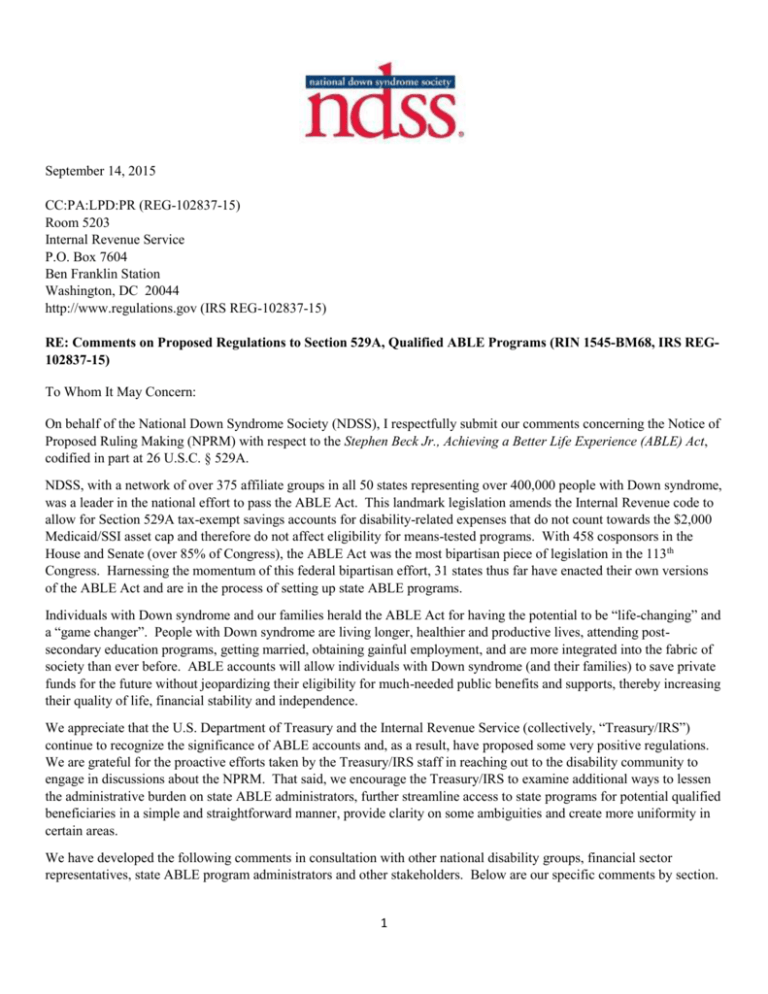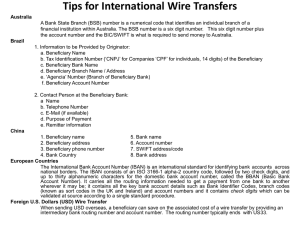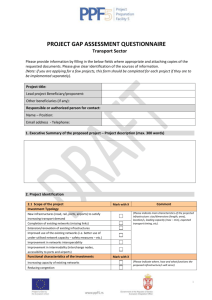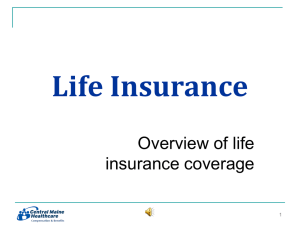here - National Down Syndrome Society
advertisement

September 14, 2015 CC:PA:LPD:PR (REG-102837-15) Room 5203 Internal Revenue Service P.O. Box 7604 Ben Franklin Station Washington, DC 20044 http://www.regulations.gov (IRS REG-102837-15) RE: Comments on Proposed Regulations to Section 529A, Qualified ABLE Programs (RIN 1545-BM68, IRS REG102837-15) To Whom It May Concern: On behalf of the National Down Syndrome Society (NDSS), I respectfully submit our comments concerning the Notice of Proposed Ruling Making (NPRM) with respect to the Stephen Beck Jr., Achieving a Better Life Experience (ABLE) Act, codified in part at 26 U.S.C. § 529A. NDSS, with a network of over 375 affiliate groups in all 50 states representing over 400,000 people with Down syndrome, was a leader in the national effort to pass the ABLE Act. This landmark legislation amends the Internal Revenue code to allow for Section 529A tax-exempt savings accounts for disability-related expenses that do not count towards the $2,000 Medicaid/SSI asset cap and therefore do not affect eligibility for means-tested programs. With 458 cosponsors in the House and Senate (over 85% of Congress), the ABLE Act was the most bipartisan piece of legislation in the 113th Congress. Harnessing the momentum of this federal bipartisan effort, 31 states thus far have enacted their own versions of the ABLE Act and are in the process of setting up state ABLE programs. Individuals with Down syndrome and our families herald the ABLE Act for having the potential to be “life-changing” and a “game changer”. People with Down syndrome are living longer, healthier and productive lives, attending postsecondary education programs, getting married, obtaining gainful employment, and are more integrated into the fabric of society than ever before. ABLE accounts will allow individuals with Down syndrome (and their families) to save private funds for the future without jeopardizing their eligibility for much-needed public benefits and supports, thereby increasing their quality of life, financial stability and independence. We appreciate that the U.S. Department of Treasury and the Internal Revenue Service (collectively, “Treasury/IRS”) continue to recognize the significance of ABLE accounts and, as a result, have proposed some very positive regulations. We are grateful for the proactive efforts taken by the Treasury/IRS staff in reaching out to the disability community to engage in discussions about the NPRM. That said, we encourage the Treasury/IRS to examine additional ways to lessen the administrative burden on state ABLE administrators, further streamline access to state programs for potential qualified beneficiaries in a simple and straightforward manner, provide clarity on some ambiguities and create more uniformity in certain areas. We have developed the following comments in consultation with other national disability groups, financial sector representatives, state ABLE program administrators and other stakeholders. Below are our specific comments by section. 1 Section 1.529A-1 Exempt Status of Qualified ABLE Program and Definitions Sec. 1.529A-1(b)(2) Contracting State Comment: We would like clarification on whether or not a state without an ABLE program can contract with multiple states (that have an ABLE program) or just a single state. Not unlike the operations of the 529 college savings plans, we believe potential ABLE beneficiaries and their families should have as wide an array of program options as possible. Providing the availability to choose between multiple ABLE programs promotes competition among the programs and thus incentivizes states to ensure lower fees and minimal costs to the beneficiary. These costs will be further reduced if multiple states are allowed to contract together into ABLE program consortiums, an idea which has been proposed by multi-state financial entities in their ABLE program design discussions. A fundamental advantage of creating an ABLE account is that it should not be cost prohibitive to families and qualified beneficiaries with relatively low to modest means. In addition, as a result of the potential longevity of the accounts, combined with the availability of saving for short and long term expenses, a qualified beneficiary should have the choice to examine other ABLE programs outside of their state of residence in order to determine the investment option(s) which would best meet his/her needs. We believe that allowing a state without an ABLE program to contract with multiple states with an ABLE program is a reasonable interpretation of the statute and is supported by the intent of the law. Furthermore, such an approach has the potential of allowing development of larger programs with the potential for broader investment choices, streamlined administration, and potentially significantly lowers fees for individual account holders. Therefore, we believe it would be in the best interests of the beneficiaries, financial planners, and ABLE program administrators to allow for multi-state contracts under a single ABLE program. Sec. 1.529A-1(b)(4) Designated Beneficiary Comment: We appreciate the confirmation on the beneficiary being the account owner, as well as an option for an individual other than the beneficiary to have signature authority in the event that the beneficiary chooses not to exercise that authority or has been determined to lack the capacity to enter into such an agreement. That being said, we would recommend that the IRS consider expanding the scope of the individuals eligible for signature authority to also include: a single designee of the parent or legal guardian (such as a sibling). Many adults with Down syndrome are fairly independent in some areas of their lives, but not necessarily completely autonomous when it comes to financial control. Some individuals enlist the help of a trusted family member or friend with money matters but are not necessarily part of a legal guardianship arrangement. Where parents are indeed the legal guardians of an individual with Down syndrome, expanding the scope of signature authority to a single designee would minimize the burden on the primary caretakers. Simply put, supporting an adult with Down syndrome is sometimes a family-wide effort. Sec. 1.529A-1(b)(16) Qualified Disability Expenses The proposed rule defines “qualified disability expenses” as “any expenses . . . that relate to the blindness or disability of the designated beneficiary of an ABLE account, including expenses that are for the benefit of the designated beneficiary in maintaining or improving his or her health, independence, or quality of life.” We applaud this definition as consistent with both the words of the statute and its intent. We agree with the statement in the preamble that “qualified disability expenses” should be broadly construed to include basic living expenses and not be limited to medically necessary expenses or expenses that benefit an eligible individual but no one else. The preamble provides one example of a qualified disability expense that fits within the definition: expenses for common items such as smart phones that serve as an effective and safe communication or navigation aid for a child with a disability. Many children with Down syndrome elope, so expenses for key locks, fencing, swimming lessons and other items that enhance their safety should also be considered qualified disability expenses. The cost of fitness classes or equipment to improve low muscle tone, a common characteristic of those with Down syndrome, is another example of an expense that should be considered a qualified 2 disability expense. We also hope that items such as special utensils, devices or seating that assist young children with eating would be considered a qualified disability expense. These three examples are illustrative; compiling an exhaustive list of qualifying disability expenses by type or by circumstance is not possible. Section 1.529A-2 Qualified ABLE Program Sec. 1.529A-2(b)(3) Community Development Financial Institutions (CDFIs) Comment: We believe that the NPRM describes the administrative responsibilities of ABLE programs to be more extensive than that of their 529 college savings plans counterparts. We do appreciate IRS’ efforts to suggest ways to relieve state administrative burden and cost. We believe that CDFIs could, with additional appropriations (government or otherwise) and the appropriate training, assist states in ABLE implementation and program maintenance. That being said, we would also recommend that IRS make it clear that other entities could play a similar role. Our concern is that states may assume that CDFIs are the only entities that have the authority to assist with the various responsibilities noted in the NPRM. Sec. 1.529A-2(c)(1) Establishment of an ABLE Account Comment: State Residency Requirement: As you may know, U.S. Sen. Richard Burr (R-NC) recently introduced an amendment to eliminate the state residency requirement, which would allow an ABLE account to be started in any state and not be limited to just the individual’s state of residence. Although this amendment was withdrawn in committee, we believe that it had merit and that eliminating the state residency requirement would simplify plans for ABLE program development and implementation, lead to a more consistent and uniform ABLE program design, minimize administrative burdens on account beneficiaries and administrators, and would make the 529A program more consistent with the traditional 529 program. We hope that the IRS will support this revision to the ABLE Act when the amendment is offered again in the future. Who Can Establish an ABLE Account on Behalf of an Eligible Individual: see Comment under “Designated Beneficiary” Sec. 1.529A-2(c)(2)(i) Only One ABLE Account Comment: We acknowledge that the statute (and subsequent NPRM) allows for no more than one ABLE account per qualified beneficiary at any single point in time (with the exception of a rollover or program to program transfer). We believe that the method of verification by way of signature under penalty of perjury does offer a reliable safeguard coupled with a limited administrative burden to the state ABLE program. Sec. 1.529A-2(c)(2)(ii) Treatment of Additional Accounts Comment: In the case of possible multiple accounts, we appreciate that the NPRM allows for a short grace period in which the funds can be returned to the contributor without unfavorable tax implications. That being said, it is unclear if those funds held by additional ABLE accounts (not the existing original account), even if returned under the given time period, would count against the qualified beneficiary’s eligibility or continued eligibility for federally funded means tested programs. We urge the IRS to clarify that this grace period will also effectively apply to eligibility status for federal means-tested benefits by treating the funds as incomplete contributions not received by the designated beneficiary. Sec. 1.529A-2(d)(1) Eligible Individual Comment: 3 The proposed rule gives states the authority to determine what documentation individuals must provide to satisfy eligibility criteria and continued eligibility. Furthermore, certification is considered filed once submitted to the state ABLE program administrator. While we appreciate the language related to the filing status, as we believe it may expedite the opening of an ABLE account for a qualified beneficiary, we do have concerns over the degree of flexibility a state is being given with respect to the specific documentation that will need to be filed. We urge the IRS to provide guidance to standardize the documentation necessary for eligibility. Consistency in proof of eligibility would minimize confusion in the disability community and would increase the likelihood that a person who qualifies for an ABLE program in one state would also qualify for the ABLE program in another state in the event that she moves and desires to roll over the account. This would also ease the burden on health care providers (who often treat patients from different neighboring states) so that they would not need to change their criteria for eligibility certifications of their patients. We urge IRS to develop a sample eligibility certification form that states could choose to adopt, which would be signed by the beneficiary under penalty of perjury. This form would contain elements such as: I. II. III. How ABLE eligibility is established (with 3 options: (1) Entitlement to benefits under SSDI; or (2) Entitlement to benefits under SSI; or (3) a disability certification of eligibility that states that (a) the individual is blind or (b) has a medically determinable physical or mental impairment that has resulted in marked and severe functional limitations and is expected to result in death, or has lasted or is expected to last for a continuous period of not less than 12 months; and A statement that the blindness or disability occurred prior to age 26; and An indication of the categories in which the diagnosis falls (this could be a check box format and list categories from IRS Form 5498-QA). Further certifications such as a recent entitlement letter for Social Security Act benefits or an authorized signature of the physician and date of diagnosis could be requested to prove eligibility, but due to privacy concerns, we recommend that the beneficiary maintains possession and control over this information but is ready to produce it if eligibility is in question. Sec. 1.529A-2(d)(2)(i) and Sec. 1.529A-2(d)(2)(ii) Frequency of Recertification and Considerations Comment: Due to the combination of characteristics that would allow an individual to be a qualified beneficiary (age of 26 requirement and severity of disability), many participants will have conditions/impairments that are not expected to improve to an extent that would disqualify them as a designated beneficiary. Down syndrome, a genetic condition diagnosed before or shortly after birth that causes varying degrees of cognitive and developmental delays and is also associated with some physical challenges and co-occurring health conditions, is an example of a condition that will not “improve”, and it would be burdensome to require such qualified beneficiaries to re-certify every year that they still have Down syndrome. For that reason, we support the ability of an ABLE program to impose different periodic recertification requirements for different impairments to minimize the administrative burden on qualified beneficiaries and program administrators. That being said, we would recommend there be as much uniformity across ABLE programs with respect to the periodic recertifications as is possible. While the compassionate allowance list does offer a good example of conditions that are unlikely to improve, there is no list that would be all-inclusive of long-term conditions and impairments. Therefore, we suggest that the original eligibility certification form include a check box and signature line for a physician to certify that the condition or impairment is not likely to improve, and that recertification should be waived for a period of 5 years after which a new recertification waiver could be filed for the next 5 years with the same stipulations. We also suggest that recertification be waived for those beneficiaries whose Social Security benefits qualify them for ABLE accounts so long as they remain on Social Security. Sec. 1.529A-2(d)(3) Loss of Qualification as an Eligible Individual Comment: 4 We support the idea of an account maintaining its status as an ABLE account during a period of time in which the designated beneficiary may no longer be a qualified beneficiary. This allows a beneficiary who may experience a temporary period of time where they no longer meet the disability criteria (such as a cancer patient in remission), the ability to still maintain the funds in the account for future use if the disability should recur. If the individual again meets the ABLE qualifying criteria, s/he would not be disqualified from supports and services due to the funds in the ABLE account and those funds would again be available to meet qualified disability expenses. 1.529A-2(e)(1) Disability Certification Comment: While we agree that the qualifying criteria in the disability certification is sound, we have come to the conclusion that requiring the state ABLE program to receive and maintain sensitive materials, particularly materials of a medical nature, could have an extensively burdensome result on the program administrators and create privacy concerns for the beneficiaries. Again, our aim is to keep administrative burden to a minimum in hopes that it will keep the cost of the programs down, and thus makes them more accessible to potential qualified beneficiaries. While the qualified beneficiary should need to meet all the criteria stated in the NPRM, including having the diagnosis of his/her impairment, signed by a qualified physician, we would recommend a form, signed under penalty of perjury, that the qualified beneficiary meets the criteria and if ever audited will produce the diagnosis related to the impairment (along with the physician’s signature) dated prior to the opening of the ABLE account. This form would serve as the disability certification. The qualified beneficiary would be responsible for holding the record of those sensitive materials while the program administrator would record but not verify how the individual is qualified. 1.529A-2(e)(3) Compassionate Allowance List and Additional Guidance Comment: See comment related to “Frequency of Recertification and Considerations”. 1.529A-2(f) Change of Designated Beneficiary Comment: We urge the IRS to allow the designated beneficiary, or parent, legal guardian, or agent with appropriate power of attorney, to establish (during the lifetime of the designated beneficiary) a “successor designated beneficiary” (SDB). The “SDB” would have to meet the federal definition of “family member” in the 529A statute. Upon the death of the designated beneficiary, the SDB would then become the designated beneficiary of the deceased beneficiary’s ABLE account. Upon the circumstance in which the SDB already has an ABLE account, the funds of the deceased beneficiary’s ABLE account would then be rolled over to the ABLE account of the SDB. This will minimize stress on the designated beneficiary and family during the end-of-life stage, and may counter any temptation to spend down the funds in the ABLE account before they become part of the beneficiary’s estate. Older individuals with Down syndrome have an increased risk of developing Alzheimer’s disease, a progressive disease that results in a gradual decline in functioning and ultimately death. Allowing for an SDB would incentivize the beneficiary’s caretakers to use the ABLE funds for the beneficiary’s end-of-life care on an as-needed basis without worrying about draining the account prior to death. 1.529A-2(h) Qualified Disability Expenses Comment: We strongly support the proposed broad definition of qualified disability expenses, including allowing for basic living expenses. Individuals with disabilities often have a wide range of needs related to their disability and we appreciate a definition that reflects this wide array of needs. In addition, relating the expenses to maintaining or improving the beneficiary’s health, independence, or quality of life further pairs the more tangible aspects of the program with the spirit and intent of the law. We also appreciate and strongly support the language stipulating that the qualified disability 5 expense need not be of medical necessity and may have coincidental peripheral benefits to an individual in addition to the qualified beneficiary. With respect to the language related to the responsibility of the ABLE program to establish a safeguard to distinguish between non-qualified and qualified distributions, there seems to be some uncertainty as to what may constitute an acceptable “safeguard.” We would recommend the IRS offer an example of what would be allowable as a “safeguard.” Additionally we would ask that the example articulate a reasonable safeguard that takes into consideration the limited administrative resources and capacities of state ABLE administrators. While we are confident that states will maintain their programs within the parameters of the law and regulations, we aim to keep administrative burden to a minimum, as we could foresee robust administrative responsibilities easily translated into overly cumbersome fees for the qualified beneficiary. We would envision an appropriate safeguard to distinguish between non-qualified and qualified distributions to be something along the lines of a single form annually filed with the state ABLE program stating that all distributions made during such year were qualified distributions and signed under penalty of perjury. Under this proposed safeguard, the beneficiary would be solely responsible for keeping receipts and other evidence of allowable expenditures, and would only need to produce this documentation if expenditures were challenged or an audit of the ABLE account was requested. This aligns with a Health Savings Account model and keeps the recordkeeping burden on the individual instead of on the state administrator. Any requirement wherein a state ABLE program would need to certify distributions as qualified on a purchase-by-purchase basis would be extraordinarily prohibitive to the beneficiary and would presumably account for exhaustive administrative burden. 1.529A-2(j) Program to Program Transfers Comment: We fully support the program-to-program option as described in Sec. 1.529A-1(b)(14) and believe it is an option that may alleviate concerns related to the 60-day permissible rollover period, specifically whether or not those funds (within those 60 days) could be counted against the qualified beneficiary’s eligibility for certain means tested benefits. While a program to program transfer may be the most efficient means to transfer funds, we still believe that the qualified beneficiary should have all the options under the law, including the 60-day rollover option, to transfer funds how they see fit. To avoid unnecessary trouble and uncertainty for beneficiaries, we urge the IRS to clarify that the funds are still within the statutory protection during a 60-day permissible rollover period. 1.529A-2(o) Change of Residence Comment: We strongly support this provision. It is foreseeable that a qualified beneficiary may over the lifetime of the account need to change residency to another state. It is important that the individual has the option to continue to maintain their ABLE account in the state in which it was established. 1.529A-2(p) Post-Death Payments Comment: (See comment related to “Change of Designated Beneficiary”). 1.529A-6 Reporting of Distributions from and Termination of an ABLE Account 1.529A-6(d) Request for TIN of Contributor(s) Comment: Current safeguards already in existence and utilized by 529 administrators make the probability of excess contributions fairly rare. In light of this, we believe that it is unnecessary for an ABLE program to have to request the TIN for each contributor at the time a contribution is made. We find that this proposed requirement adds undue burden. We would ask 6 that the ABLE administrators only have to obtain a contributor’s TIN in the unlikely event that an excess contribution makes it past their system and has been determined to have accrued interest. Conclusion As the largest nonprofit representing the Down syndrome community in the United States, we again express our appreciation for the openness and collaborative spirit shown by Treasury/IRS throughout this process. After working to pass the federal ABLE Act for nearly a decade, our organization is committed to ensuring the availability of ABLE accounts in all 50 states in the very near future. In order for these accounts to be the “game changer” that our members are anticipating, they need to be affordable and accessible, both of which will be accomplished by streamlining the requirements and reducing the administrative burden. We thank the Treasury and the IRS for the prompt release of the NPRM and for the thoughtful evaluation of the statute, and look forward to the public hearing on October 14, 2015. If you have any questions concerning our comments, or would like further clarification/explanation on any aspects included in this document, please contact Heather Sachs, Vice President of Advocacy & Public Policy at hsachs@ndss.org. Sincerely, Sara Hart Weir, MS President National Down Syndrome Society 1602 L Street, NW Suite 925 Washington, DC 20036 (202) 465-3222 sweir@ndss.org 7





